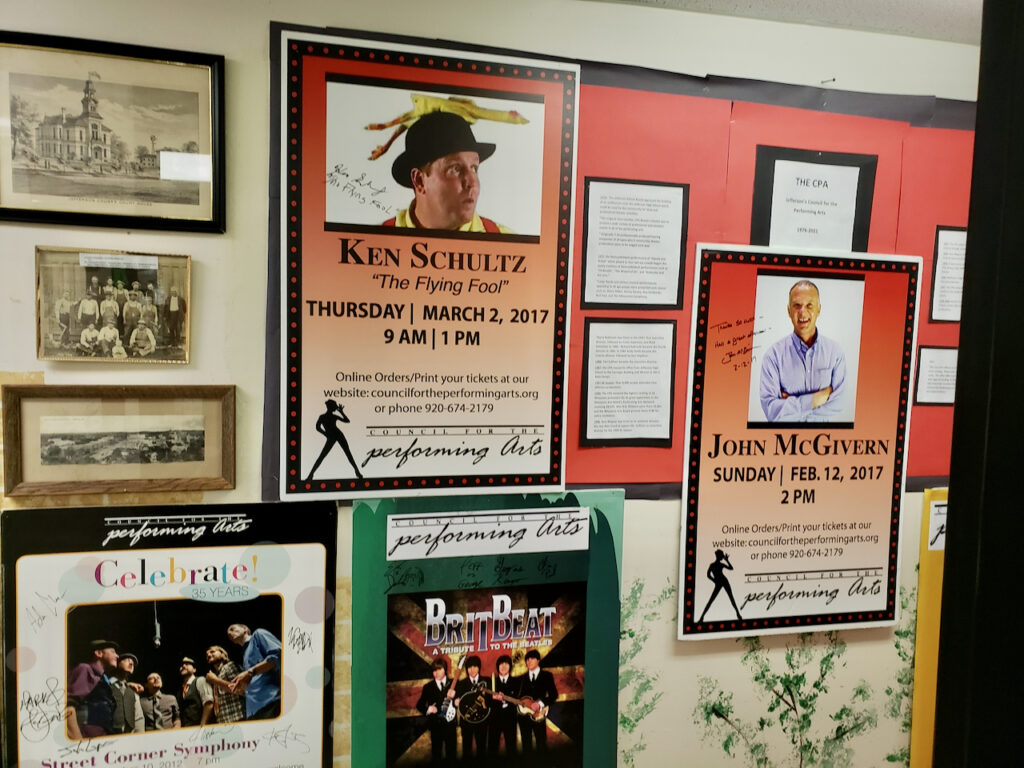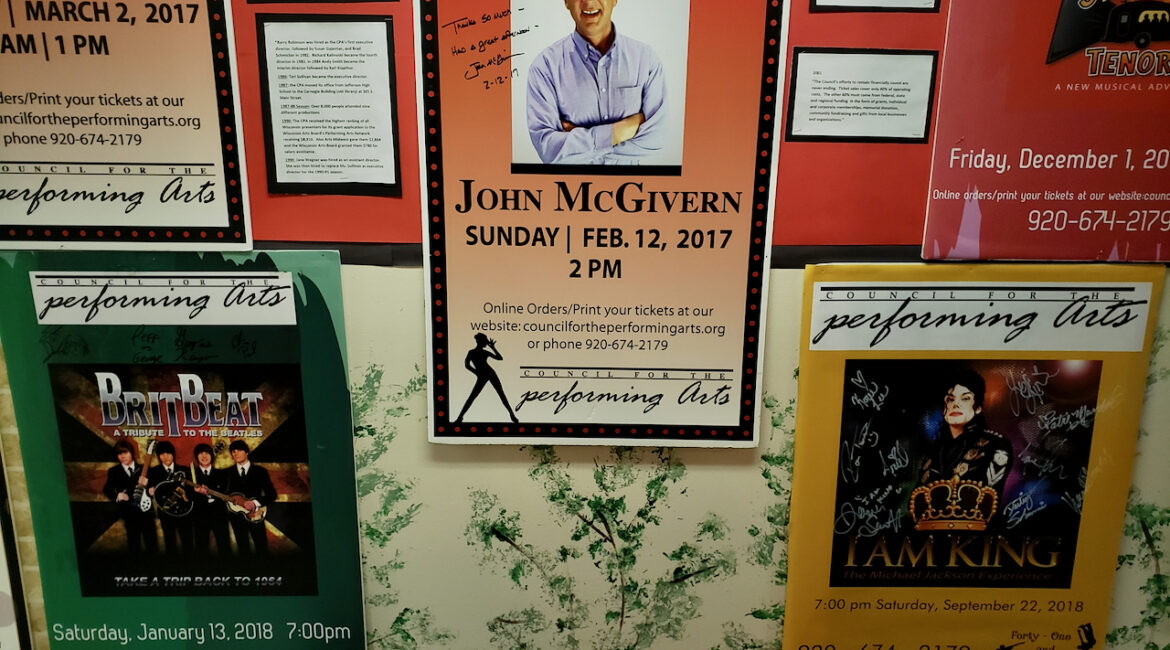By Chris Spangler
Visitors to the Jefferson Historical Museum these days are greeted by television host John McGivern, Michael Jackson and Beatles tribute musicians and the self-proclaimed “Flying Fool.”
They’re just a few of the faces in a display of autographed posters publicizing some of the thousands of acts that entertained audiences at the Jefferson County Council for the Performing Arts during the past four-plus decades.
On Dec. 22, 2021, the CPA Board of Directors voted to dissolve the organization that for 44 years had brought both local and big-name entertainment to Jefferson. It has donated its posters, playbills and other memorabilia to the museum.
“It has been a long run, but the last years have been very difficult to grow the board and fundraise enough to keep the organization viable,” the board announced on its Facebook page in late December.
Founded in 1977 by a group of arts-minded Jefferson County residents, the CPA presented the majority of its programs in the 1,000-seat Jefferson High School auditorium. Its programming featured dance, theater, comedy and music, with the mission of providing local, regional and professional performing arts entertainment for people of all ages close to home at affordable prices.
Board President Peg Bare said that dissolving the CPA was a difficult, albeit necessary, decision.
“The hardest thing was that we needed to have 13 members on the board and we had five right now,” she said. In addition, people are very busy, and that was a continuing problem. You need new people for fresh ideas.”
Not surprisingly, money also was a grave concern.
“You have the fundraising so that you can keep things going, but you also don’t want to be always fundraising,” Bare said, noting that it was important to have money for not only the acts, but for a paid director.
“It makes a big difference to have someone there and not having a board running the CPA,” she said. “A board should be a supporter of the director.”
Bare said that, while the CPA had its monetary ups and downs throughout the decades, it had been tightening its belt and appeared to be getting finances under control in recent years.
“We had a great show with (“Around the Corner” host) John McGivern, we were excited for the next year, and we were looking at a show with violinist Mark Wood, one of the founders of the Trans-Siberian Orchestra,” she recalled, noting that Wood was to lead a workshop with the Fort Atkinson High School orchestra, which would perform a song in his evening show.
“We also were looking at an Irish music program,” Bare said. “I had talked to that group and then COVID hit. And then the theater closed.”
Shelter-at-home and social distancing mandates devastated the entertainment industry.
“All of a sudden, you don’t have a place to perform,” Bare said. “We were going to have four shows that year and then COVID hit. We told ourselves, ‘OK, we’ve got to hang on.’”
The board talked with ASCAP and the CPA’s peer organizations.
“Everybody else like us was in the same boat. You still have to pay the fees for an office. You still have to put up money for shows. We still were trying to stay alive,” Bare said.
The board applied for grants, receiving one from the Randy Schopen Foundation and another from the state to help it pay the rent, insurance and licenses to keep the CPA going.
“But with school closed, school open, maybe 300 people allowed in the theater, maybe closed by the time we booked something, we didn’t know what was going to happen,” Bare said.
Social distancing meant that only 300 people, fewer than a third of the auditorium’s capacity, would be allowed to attend performances; however, the acts on stage still needed to be paid full price.
“Now we had to look at how much we were going to have to charge to break even, and whether people were going to pay that much to come to an event, Bare said.
She acknowledged that this was not the first time that the CPA was in a bind. In recent years, the number of season ticketholders had declined.
“A lot of our regular season ticketholders were snowbirds in winter and a lot of people now do travel out of town to see entertainment,” Bare said. “When the CPA was formed, the Fireside (Dinner Theatre in Fort Atkinson) didn’t have a theater. The Gobbler wasn’t a theater.”
Neither did the Irvin L. Young Auditorium at the University of Wisconsin-Whitewater exist four decades ago.
She said the CPA had been looking at how to attract a younger age group to performances, exposing children to live theater.
“That’s why we had Janet’s Planet and Vocal Trash,” Bare said, citing programs that promoted conservation and recycling. “We did afternoon shows and bussed in school kids. We also had shows for adults. Those were fun shows; the kids really liked them.”
Two years ago, the CPA moved from its longtime home in the Fort Community Credit Union’s Puerner Building to FOCUS Coworking in the former fire station.
While FCCU had been very generous in providing a large, rent-free office space, Bare said, the CPA still had to pay for its utilities, cable, copy machine lease and other necessities.
At its peak, the CPA had four employees and a director. Two years ago, with a much smaller staff, it no longer needed so much space. The amenities came with the rent at FOCUS, so the CPA’s overall cost was less, Bare explained.
But the pandemic was the final straw.
“COVID made it really hard. We pretty much were fundraising to keep the door open,” she said. “It was hard to ask businesses for money. We did have a few-thousand dollars left. We were debating whether to put on a show, but we knew we most likely would go in the red if we did. And then there was the possibility that the theater might not be available if we booked it.
Thom last director
Trudianne Thom, who for 28 months served as the last formal director of the CPA, agreed with Bare’s assessment.
“I’m so sad it is gone,” she said of the CPA, citing the combination of no new life on the board, competition with the Irvin L Young Auditorium and other venues, a lack of volunteerism and funding.
“Some of the problems were the difficulty selling tickets for shows during the winter when all summer there were great shows in the park for free,” she said.
“The facility was now 40 years old with seating that was worn, sad and uncomfortable,” Thom continued. “The school district gave the impression that the CPA was a major inconvenience to the use of the facility.”
Thom said that she had wanted to sponsor and produce more children’s shows.
“Filling the seats with schoolchildren is always a win-win situation in that you are introducing a new audience to live theater and hopefully inspiring new actors,” she said. “And with a minimal ticket price, you could cover all expenses plus carry over for other general expenses.”
Thom recalled that when she came on board as director, she hoped to revitalize the Gemuetlichkeit Days play, of which she had been a big part for many years.
However, at least one person voiced concern, apparently thinking that the family productions on Gemuetlichkeit Days weekend would take away attendance at the German-heritage festival itself.
“An older member of the Gemuetlichkeit committee came down to the CPA office and literally yelled at me for half-an-hour about competing with Gemuetlichkeit,” Thom said. “I had seen it as an enhancement.”
She added, “I have a lot of fabulous memories of creating costumes, building sets, directing the play and, in fact, writing and producing two original plays for that fall festival. And this play made enough money to carry expenses for the CPA for several months.”
Thom said that fundraising always was difficult, acknowledging that was not her strength.
“I always thought of the CPA as a countywide organization to be proud of all that was accomplished,” she said. “However, over the years, it must have been easier to just go to the City of Jefferson residents for fundraising, and I think they were tired and no longer interested in the support.”
Thus, the CPA Board of Directors was faced with a difficult, but inevitable, decision.
“It came to the decision that maybe it was time to dissolve the CPA,” Bare said, noting that the organization was in the black and its loan had been paid off.
“We had a little bit of money left, so we decided to donate it to other nonprofits,” Bare said.
Donations made
Selected as beneficiaries were the Jefferson High School Drama Club, which has garnered statewide awards for its one-act plays; the Jefferson Music Live Music Foundation, sponsor of the Concerts in the Park in Rotary Waterfront Park; the Randy Schopen Foundation; and the Jefferson Kiwanis Club.
“We decided to give money to organizations that will continue our mission,” Bare said. We thought the first two would continue providing entertainment to the community and the second two would be good organizations to donate to.”
In addition, the stage lighting, baby grand piano and other equipment the CPA purchased or helped pay for throughout the years stayed with the school.
The Jefferson Historical Museum received posters signed by the visiting artists, a huge box full of programs that go back to the organization’s start, books of board minutes, original founding paperwork and a large CPA sign and rug.
The donation also included seven huge scrapbooks with photos from the various sponsored events.
Show scripts, however, had to shred because they were copyrighted materials.
A look back
A sampling of entertainment through the years shows both big-name performers and community theater members.
The Lettermen, New Orleans’ Preservation Hall Jazz Band, Burl Ives and the Milwaukee Reparatory Theater performed on the auditorium stage.
The 2017-18 season featured “Forty Fabulous Years” with the 3 Redneck Tenors; Brit Beat, a Beatles tribute band; a Valentine Day’s evening with the Third Lake Trio; and “Sweet Dreams and Honky Tonks,” saluting classic artists and stories of their lives.
Up the following year were “I Am King: The Michael Jackson Experience;” Divas Through the Decades; and “It’s a Wonderful Life” performed in a 1940s radio show format.
Local theater included “The Wizard of Oz,” “Annie,” “Showboat,” “Follies in Concert” and “Charlie and the Chocolate Factory.” Many local productions were presented as the Gemuetlichkeit Days play, while others drew actors and technical staff from nearby communities, including the Fort Atkinson Community Theatre.
“There were a lot of fantastic community plays produced there, like ‘Follies,’ ‘1776,’ ‘On Golden Pond,’ ‘You Can’t Take It With You,’ ‘Miracle on 34th Street,’ ‘Wizard of Oz”(with a cast of 112),’ ‘Fiddler on the Roof,‘ ‘Peter Pan,’ ‘Androcles and the Lion’ and ‘Annie,’” Thom said.
“The list goes on and on,” she added.
Fundraisers included a Pajama Party in 2013 and auction titled “Your Vegas is Showing” in 2014, followed in 2015 by a Halloween-themed event.
44 years of history
The Council for the Performing Arts was founded right after the high school auditorium was constructed in 1976 as part of a School District of Jefferson $3.7 million building and expansion program.
It featured prime seating for nearly 1,000 persons, a 64-by-44-foot stage, computerized rigging systems and sophisticated lighting and sound systems that made it one of the region’s finest performing halls.
The charter board of directors of what at first was called the Jefferson Area Enrichment and Entertainment Council consisted of President James Schweiger, Vice President George Kuske Jr., Secretary John Pearson, Treasurer Mrs. Lloyd Buske, Ormal Kiesling, Victor Buelow, Toby Tully, John Danforth, Steven Swanson, Sister Carol Goettl, Mrs. Jeffrey Hamann, Mrs. John Phelps, Mrs. Bernellyn Olsen, Mrs. Donald Hoffman and Steven Fossum.
The minutes of its April 14, 1977, meeting shed light on the Steering Committee’s thoughts on the CPA’s direction.
“It was mentioned by Mr. Rogan that possibly the Milwaukee Chamber Music Society would be contracted for appearance in late May at a cost of $2,500. This held great interest for the group, and Mr. Rogan was instructed to further investigate the possibility,” the minutes state. “Mr. Buske stated that he did not feel that we should take the Milwaukee Symphony away from Fort, and this seemed to be the concensus of the committee.”
At the time, the Milwaukee Symphony Orchestra performed annually in the Fort Atkinson High School gymnasium.
Also during the meeting, the minutes read, “Mr. Swanson stated that he had hoped that more than ‘long hair’-type programs would be offered in the auditorium and stated that such things as orchestras, plays, children’s theater, dance bands, ballets, rock-and- roll and a variety of other types of performances that would meet the varied interests of Jefferson citizens within the School District of Jefferson. Mr. Buske agreed and thought that perhaps dance groups representing the various ethnic groups would be acceptable.”
Sister Goettl asked whether institutions such as what at the time was called St. Coletta School would receive reduced rates, bringing in larger numbers of attendees, according to the minutes. “Mr. Rogan said that might be the case in the future for programs where the margin of profit would permit such consideration. However, for the initial presentation, the board would go on a ‘break-even basis.’”
Members discussed how often the CPA should hold performances, as well as concerns about “competing” with Fort Atkinson.
“Mr. Kiesling said that Jefferson historically does not support cultural activities very well and that he felt that it was a tragedy,” according to the minutes. “He mentioned, for instance, when an excellent band from Iowa performed and that only 10 people appeared. He said that we must find out what programs the people want.”
Dr. Pearson suggested a newspaper article with a reader suggestion card to be returned to the committee.
The board also discussed selecting performers, advertising, ticket sales, concession stands and technical aspects of the auditorium. Mr. Rogan volunteered to contribute tickets and advertising posters for the first show.

Peggy Bare displays show programs spanning the Jefferson County Council for the Performing Arts’ 44 years. Bare was the CPA Board of Directors president when it voted to dissolve in December. Chris Spangler photo.




Four photos above: CPA member Eve Horton shares photos of past productions, including: “The Wizard of Oz” in 1990;” “Peter Pan,” which was the Gemuetlichkeit Days play one September; “As We Forgive Those,” with actors Don Hinz and Bob Horton pictured, in 1994; and “A Little Night Music” in 1991, with actors Horton and Estelle Wiesmann pictured. Eve Horton photos.

Musical Director Craig Engstrom, from left, Trudianne Thom and choreographer Susan Knutson pose for a group photo in 1990 during a production of “The Wizard of Oz.” Contributed photo.



Three photos above: Vicki Schicker, at top, curator of the Jefferson Historical Museum, stands near a display featuring memorabilia donated by the Jefferson County Council for the Performing Arts. Posters, signed by some of the entertainers who appeared in council productions throughout the years, are on display at the museum. Chris Spangler photos.
This post has already been read 1502 times!
